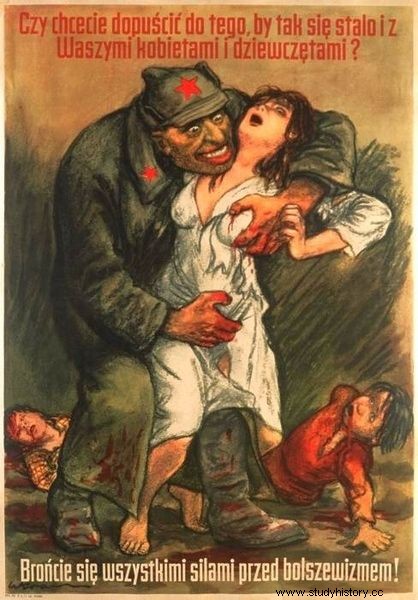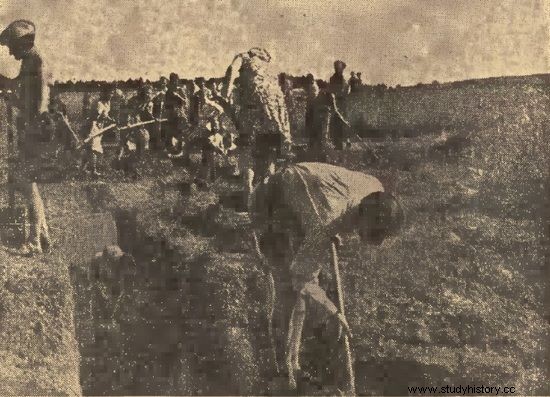If you asked someone on the street what the Varsovians were doing in August 1944, the answer would probably be:they took part in the uprising. And what were the inhabitants of Kraków doing at the same time? Well, the inhabitants of the city near Wawel volunteered to ... build fortifications for the German army.
Along with the ever closer collapse of the "thousand-year-old" Reich, the attitude of the German occupant towards Poles in the General Government (GG) was changing to some extent. The so-called "Flexible course". Its purpose was to persuade the inhabitants of the General Government to cooperate in stopping the advancing Red Army.
Among other things, it was thought of establishing Polish auxiliary forces at the Wehrmacht, but the plan did not work out at all. Initial estimates, reaching even 175 thousand. volunteers turned out to be a pipe dream.

This is how the Nazis persuaded Poles to cooperate ...
During November and December 1944, at the recruitment point in Kraków at ul. Lubomirskiego 19, less than 500 people applied. The case of building fortifications east of Krakow, which was described by professor Andrzej Chwalba in the book "Okupacyjny Krakow in 1939-1945", was different.
Let's grab the shovels
The rapid advances of the Red Army in the summer of 1944 made the city of Krak a front-line town. On August 6, information was posted about the recruitment of volunteers to build the "protection dyke" (also called the eastern dyke by the author). It was supposed to be a barrier against the Bolshevik onslaught from the east.
To the great amazement of the Germans, on the appointed day - August 24 - a large crowd of Poles gathered in front of the Main Railway Station in Krakow, wanting to put a shovel on this cannon . It turned out that the tools were enough for only half of them, what's more, according to German reports, the atmosphere was exceptionally good .
The Polish underground was also surprised. As Andrzej Chwalba notes:
Anger was mixed with a feeling of helplessness, contempt for the so-called shovel knights with their condemnation. They were considered "little people" lined with a coward, comforters, and they were seen as "Krakow's knots".

While the uprising was taking place in Warsaw, the Germans recruited people in Kraków to build fortifications to stop the Red Army. And surprisingly, there were many who volunteered to work. The photo shows an appeal placed in the reptilian "Goniec Krakowski" of August 1, 1944.
In his leaflet, the District Government Delegate tried to explain the attitude of young Cracovians due to terror and threats that made them decide to help the Nazis. But the truth was a bit different.
The main reason for the high attendance was the "bonuses" offered by the occupant. In addition to being released from the previous hard work, the volunteer received additional allowances of cigarettes, alcohol, food stamps, the possibility of night escapades, etc. The opportunity to smuggle various goods on uncontrolled trains running between Krakow and the site of earthworks was also important.
In the initial period, the Germans did fulfill their promises, which is why more and more people willing to work voluntarily appeared on the embankment. Nevertheless, as many times before, after a while "allowances" ceased to be paid and labor became more and more slave.
This resulted in a decrease in the number of people willing to participate in the defense of the "thousand-year-old" Reich. Certainly, the underground reaction also did its job, announcing that voluntary participation in digging fortifications was tantamount to working for the enemy, for which there was only one penalty - a bullet to the head. Metropolitan Sapieha also issued a special pastoral letter on this matter.
Old best practices
All these factors meant that the Germans had to resort to well-tested recruitment methods - displaying personal lists of "compulsory volunteers". It fell on the years 1909-1928. However, even that did not help:only 20-30% of the people assigned to build the fortifications applied for work.

Women from Kraków working on the construction of German fortifications. Photo published in "Goniec Krakowski" on August 15, 1944.
In such a situation, the occupant had no choice but to use "arguments" of the heaviest caliber. On September 11, a poster appeared with the names of people sentenced to death for sabotage of work on the defense trenches .
As a sweetness, on September 22, Governor Hans Frank decided to reward the most zealous "diggers". As we can read on the pages of "Occupied Krakow ...", they received:

an opportunity to pay tribute to the bards, kings and Piłsudski . After a joint tour with the governor-general, during which an orchestra of miners from Wieliczka played, the heroes of the work "on the ramparts" received valuable gifts and diplomas:"In recognition of their contribution to the construction of the rampart in 1944 - Frank.
It was not the first such "play" on Frank's part. It is enough to recall the situation of March 1943, when the "king of Poland", sending a one million forced laborer from the Krakow train station to the Reich, handed him a gold watch.
However, everything was in vain. The Cracovians cured themselves of their temporary "weakness" and had to be dragged to work, so to speak, with oxen. Nevertheless, a certain distaste remained, and this history is hardly discussed in Krakow - I wonder why?
